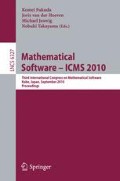Abstract
This paper presents a computational framework that allows for a robust extraction of the extremal structure of scalar and vector fields on 2D manifolds embedded in 3D. This structure consists of critical points, separatrices, and periodic orbits. The framework is based on Forman’s discrete Morse theory, which guarantees the topological consistency of the computed extremal structure. Using a graph theoretical formulation of this theory, we present an algorithmic pipeline that computes a hierarchy of extremal structures. This hierarchy is defined by an importance measure and enables the user to select an appropriate level of detail.
Access this chapter
Tax calculation will be finalised at checkout
Purchases are for personal use only
Preview
Unable to display preview. Download preview PDF.
References
Aim@Shape, http://shapes.aim-at-shape.net/
Cayley, A.: On contour and slope lines. The London, Edinburg and Dublin Philosophical Magazine and Journal of Science 18, 264–268 (1859)
Cebral, J., Castro, M., Appanaboyina, S., Putman, C., Millan, D., Frangi, A.: Efficient pipeline for image-based patient-specific analysis of cerebral aneurysm hemodynamics: technique and sensitivity. IEEE Transactions on Medical Imaging 24(4), 457–467 (2005)
Chari, M.K.: On discrete Morse functions and combinatorial decompositions. Discrete Math. 217(1-3), 101–113 (2000)
Chen, G., Mischaikow, K., Laramee, R.S., Pilarczyk, P., Zhang, E.: Vector field editing and periodic orbit extraction using Morse decomposition. IEEE Transactions on Visualization and Computer Graphics 13(4), 769–785 (2007)
Edelsbrunner, H., Harer, J., Zomorodian, A.: Hierarchical Morse complexes for piecewise linear 2-manifolds. Discrete Computational Geometry 30, 87–107 (2003)
Forman, R.: Combinatorial vector fields and dynamical systems. Mathematische Zeitschrift 228(4), 629–681 (1998)
Forman, R.: Morse theory for cell complexes. Advances in Mathematics 134, 90–145 (1998)
Hatcher, A.: Algebraic Topology. Cambridge University Press, Cambridge (2002)
Joswig, M., Pfetsch, M.E.: Computing optimal Morse matchings. SIAM J. Discret. Math. 20(1), 11–25 (2006)
Lewiner, T.: Geometric discrete Morse complexes. Ph.D. thesis, Department of Mathematics, PUC-Rio (2005), advised by H. Lopes, G. Tavares
Maxwell, J.C.: On hills and dales. The London, Edinburg and Dublin Philosophical Magazine and Journal of Science 40, 421–425 (1870)
Milnor, J.: Topology from the differentiable viewpoint. Univ. Press Virginia (1965)
Reininghaus, J., Hotz, I.: Combinatorial 2d vector field topology extraction and simplification. In: Pascucci, V., Tricoche, X., Hagen, H. (eds.) Topology in Visualization 2009 (to appear 2010)
Rosanwo, O., Petz, C., Prohaska, S., Hotz, I., Hege, H.C.: Dual streamline seeding. In: Eades, P., Ertl, T., Shen, H.W. (eds.) Proceedings of the IEEE Pacific Visualization Symposium, pp. 9–16 (2009)
Schrijver, A.: Combinatorial Optimization. Springer, Heidelberg (2003)
Stalling, D., Westerhoff, M., Hege, H.C.: Amira: A highly interactive system for visual data analysis. In: The Visualization Handbook, pp. 749–767 (2005)
Weinkauf, T.: Extraction of Topological Structures in 2D and 3D Vector Fields. Ph.D. thesis, University Magdeburg and Zuse Institute Berlin (2008)
Weinkauf, T., Günther, D.: Separatrix persistence: Extraction of salient edges on surfaces using topological methods. Computer Graphics Forum (Proc. SGP 2009) 28(5), 1519–1528 (2009)
Wischgoll, T., Scheuermann, G.: Detection and visualization of closed streamlines in planar flows. IEEE Transactions on Visualization and Computer Graphics 7(2), 165–172 (2001)
Author information
Authors and Affiliations
Editor information
Editors and Affiliations
Rights and permissions
Copyright information
© 2010 Springer-Verlag Berlin Heidelberg
About this paper
Cite this paper
Reininghaus, J., Günther, D., Hotz, I., Prohaska, S., Hege, HC. (2010). TADD: A Computational Framework for Data Analysis Using Discrete Morse Theory. In: Fukuda, K., Hoeven, J.v.d., Joswig, M., Takayama, N. (eds) Mathematical Software – ICMS 2010. ICMS 2010. Lecture Notes in Computer Science, vol 6327. Springer, Berlin, Heidelberg. https://doi.org/10.1007/978-3-642-15582-6_35
Download citation
DOI: https://doi.org/10.1007/978-3-642-15582-6_35
Publisher Name: Springer, Berlin, Heidelberg
Print ISBN: 978-3-642-15581-9
Online ISBN: 978-3-642-15582-6
eBook Packages: Computer ScienceComputer Science (R0)

